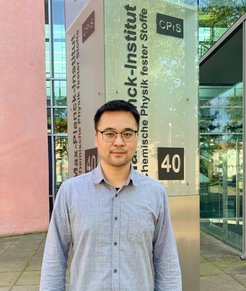Erjian Cheng
Humboldt Fellow as of May 2023

A synopsis of my research proposal
My research, supported by the Alexander von Humboldt foundation, aims to experimentally investigate the intricate interplay between magnetism, electron correlations, and topology in magnetic topological materials (MTMs), using techniques such as electrical, thermoelectric, and thermal transport measurements. Especially, uniaxial strain based on piezoelectric apparatus and pressure techniques will be compatible with electrical and thermoelectrical probes to systematically study these effects. Recently, the investigation of MTMs attracts enormous attention in condensed matter research, both experimental as well as theoretical studies. It is out of doubt that breaking time-reversal symmetry (TRS) has profound consequences for topologically non-trivial electronic states, and the nonzero net Berry curvatures in MTMs with broken TRS can induce unique properties such as intrinsic anomalous Nernst/Hall effects (ANE/AHE), topological Hall/Nernst effects, topological magnetic textures (for example, skyrmions, hedgehogs, merons, magnetic bubbles, hopfions, etc.). Additionally, the interplay between magnetism and topology remains mysterious but is expected to be promising for the realization of novel topological states. Therefore, one expects new states of matter switchable in external magnetic fields and even the often-discussed application potential of topologically protected (spin-) states could be enormously boosted in MTMs. As the origin of many quantum phases, electron correlations could play a significant role in MTMs, since the amplified quantum fluctuations may produce abundant phases of matter and various quantum phase transitions.
The methods of choice for studying MTMs are detailed magnetoelectrical and magnetothermal transport measurements, which give a direct access to topological protection of electronic states, Berry curvatures, quantized transport etc. In MTMs, the location of Weyl/Dirac points relative to the Fermi level (EF) has a significant impact on the transport behavior arising from topological electronic states, and this may affect their detectability. In real-world MTMs, the EFs are often not located precisely at the Dirac/Weyl points. To achieve accurate tuning, chemical doping and defect-manipulation techniques are usually used, but they have drawbacks such as difficulty in precise and continuous doping, introduction of extra disorders, and difficulties in theoretical calculations. Therefore, alternative tuning techniques such as band engineering should be explored. This proposal employs strain and pressure tuning techniques to adjust the crystal structures of MTMs, leading to fine-tuning of their band structures. These tuning techniques may also induce changes in magnetic configurations, electron correlations, and symmetries, which may result in the emergence of exotic topological states or topological phase transitions. Measurements will be performed as function of temperature, magnetic field, pressure, and uniaxial strain. From these data, the intertwined interplay between magnetism, electron correlations, and topology will be investigated in great detail. Together with cooperation partners from the field of theory, the role of each influencing factor or their synergistic effect on topology in several MTMs will be elucidated. In the long term, this research will contribute to laying the foundation for a sophisticated and unified theory for MTMs, and for the tuning of topology to enable practical applications in spintronics and thermoelectrics.
Why I choose our institute
Prof. Claudia Felser is a knowledgeable and world-renowned scientist. Her group has made significant progress in the field of topological materials and topological physics, and their extensive understanding of physics and chemistry can offer valuable insights into the transport properties of the materials I study. Within her group, the abundant experience in crystal growth, and advanced transport measurement equipment provide a sound foundation for implementing my independent research plans. Besides, collaborating with her group members who perform DFT calculations and angle-resolved photoemission spectroscopy measurements will help to reveal the band structure of these materials and understand the underlying physics. Due to the international and diverse community of exceptional researchers in her group, I have ample opportunities to collaborate with them, and engage in productive discussions. In short, her group provides me an outstanding research experience in the field of topological physics and material science.
